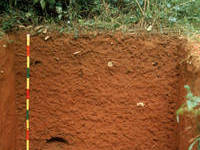Soil classification

- Deep red Acrisol derived from granite in almost level terrain, China
Soil Classification concerns the grouping of soils with a similar range of properties (chemical, physical and biological) into units that can be geo-referenced and mapped. Soils are a very complex natural resource, much more so than air and water.
Soils contain all naturally occurring chemical elements and combine simultaneously solid, liquid and gaseous states. Moreover, the number of physical, chemical and biological characteristics and their combinations are nearly endless. No wonder then that many different approaches have been proposed to come to a sensible grouping of different soils. Also soil classification systems were developed for different purposes :
- Soil Taxonomy to interpret soil surveys;
- The FAO Legend for representing the global distribution and geography of soils;
- WRB to facilitate correlations between different soil classification systems
One can distinguish three different stages to illustrate the development of soil classification systems. Early soil classification systems (Russian, USDA 1938) focused on the environment and the soil forming factors to classify soils in zonal soils (in which the pedogenesis was mainly determined by climate and vegetation) and azonal and intrazonal (in which pedogenesis was mainly determined by parent material and time of development). The difference between azonal and intrazonal soils was made on the basis of soil profile development. A later development focused on the processes occurring in the soil itself (such as ferallitisation, salinization, leaching and accumulation etc…). These processes were roughly characterized by soil properties. A good example of the latter approach is the French classification system (CPCS, 1967). Modern soil classification started with the publication of the 7th Approximation of the USDA Soil Taxonomy, where precisely defined and quantified soil properties as such, or in combination, were used to define “diagnostic soil horizons”.
Postmodern soil classification approaches make extensive use of statistics and fuzziness and include numerical soil classification systems (developed by among others: Webster, Fitzpatrick and McBratney).
